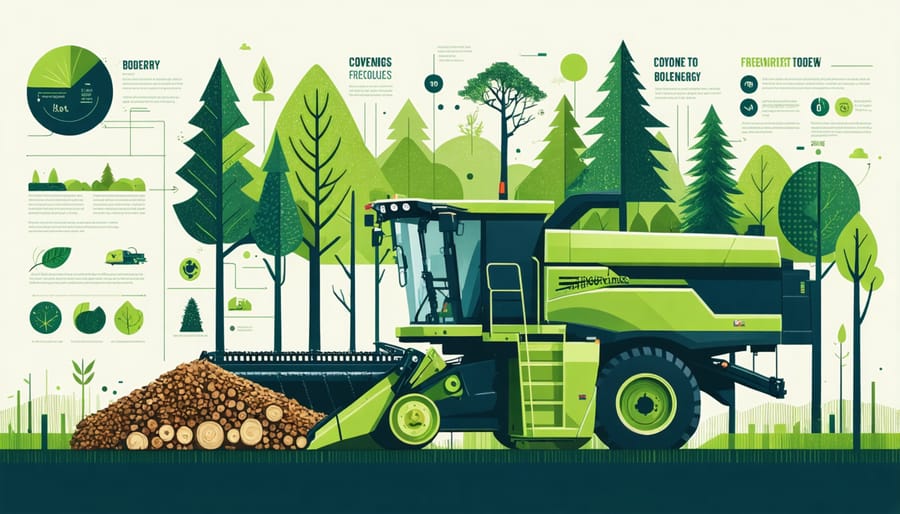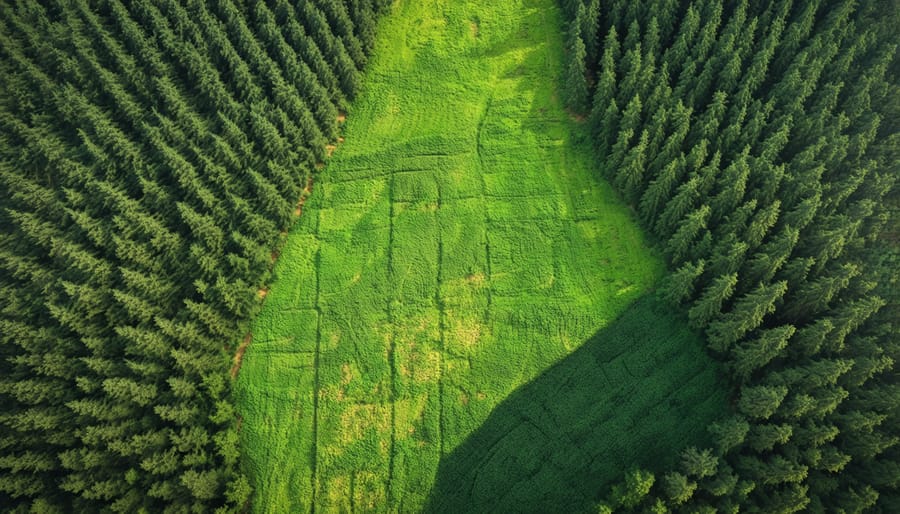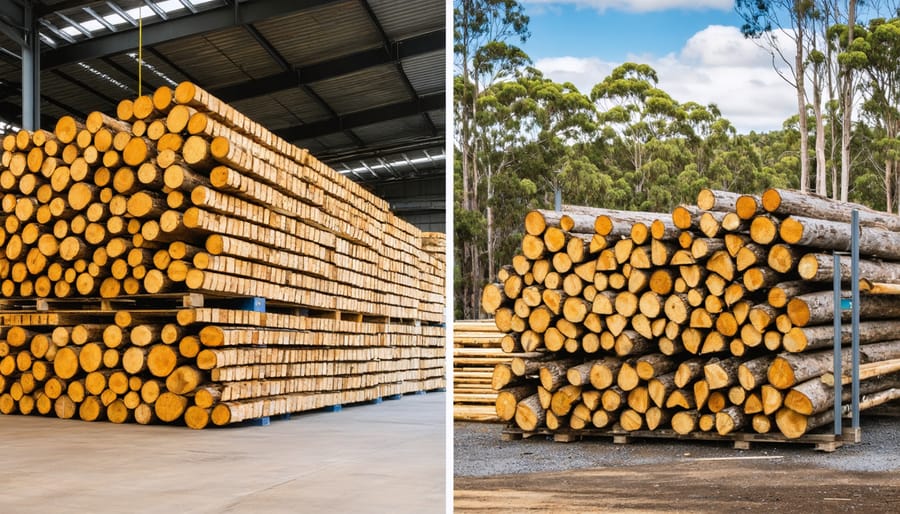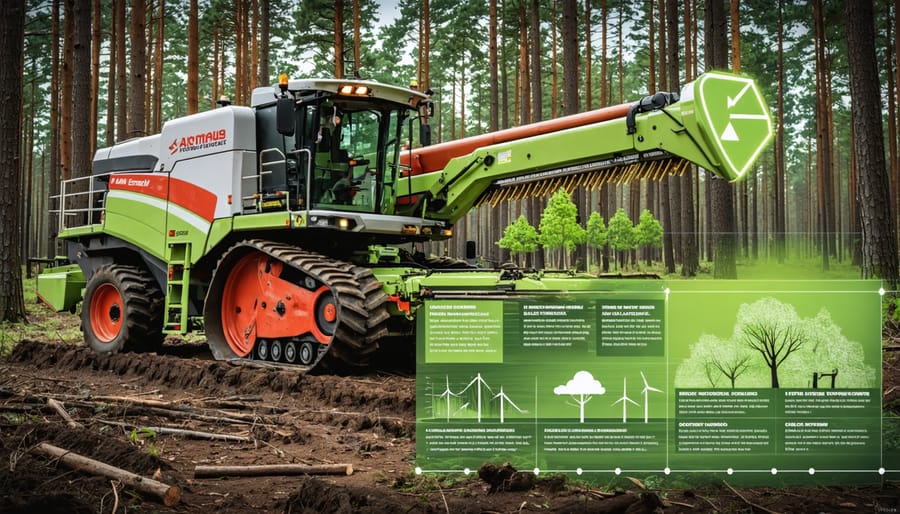Australia’s sustainable forestry sector stands at the forefront of renewable energy innovation, transforming traditional timber production into a powerful catalyst for environmental stewardship. By harnessing forest residues and sustainably managed wood products, the industry now provides crucial bioenergy resources in Australia while maintaining vital ecosystem services.
From sawmill waste powering local communities to advanced wood pellet production supporting clean energy transitions, sustainable forestry products represent a critical intersection of environmental conservation and renewable energy generation. These innovations not only reduce waste and carbon emissions but also create new revenue streams for regional communities, demonstrating how thoughtful resource management can deliver both ecological and economic benefits.
The transformation of Australia’s forestry sector showcases how traditional industries can evolve to meet modern sustainability challenges. By implementing strict certification standards, utilizing advanced harvesting techniques, and maximizing resource efficiency, the industry has created a model for responsible resource management that benefits both present and future generations.
Sustainable Forestry Products: The Building Blocks of Bioenergy
From Forest Waste to Energy Gold
In Australia’s vast forestry operations, what some might consider waste is increasingly becoming a valuable renewable energy resource. The transformation of energy from forest residues represents a game-changing opportunity for our timber industry and clean energy future.
When trees are harvested, up to 50% of the biomass traditionally remains unused – including branches, bark, and off-cuts. Rather than letting these materials decompose or become fire hazards, forward-thinking operations are converting them into sustainable bioenergy. This process not only reduces waste but also creates a reliable source of renewable energy.
The Mount Gambier region in South Australia showcases this potential brilliantly. Local timber processors have partnered with energy providers to convert their forestry residues into power for both their operations and the local community. This initiative has created new jobs while reducing the region’s carbon footprint.
The conversion process is remarkably efficient. Modern biomass facilities can transform forest residues into various forms of energy, from electricity to heat, using advanced combustion technologies. What’s more, this practice helps maintain forest health by removing excess debris that could fuel bushfires.
For every tonne of forestry residues converted to bioenergy, approximately one tonne of CO2 emissions from fossil fuels is avoided. It’s a win-win situation that’s turning our forestry sector into a renewable energy powerhouse while supporting sustainable forest management practices.

Purpose-Grown Energy Forests
Across Australia, dedicated energy forests are revolutionising the way we think about renewable energy production. These specially managed plantations of fast-growing trees represent a significant advancement in purpose-grown bioenergy crops, offering a sustainable solution to our energy needs while supporting environmental conservation.
These energy forests typically feature carefully selected species like Blue Mallee, Oil Mallee, and various eucalyptus varieties, chosen for their rapid growth and high energy yield. What sets them apart is their dual benefit: while growing, they sequester carbon and improve soil health, and when harvested, they provide a reliable source of renewable energy.
The success of these plantations lies in their strategic management. Trees are planted in dense formations and harvested on regular cycles, usually every 3-5 years, allowing for continuous regrowth from the same rootstock. This coppicing system means one planting can provide multiple harvests over several decades, making it both economically viable and environmentally sustainable.
Leading the charge is the Green Triangle region, straddling Victoria and South Australia, where energy forests are already powering local communities. These plantations demonstrate how careful planning and proper management can create a win-win situation – providing clean energy while maintaining biodiversity and protecting native ecosystems.
For farmers and landholders, energy forests offer a promising diversification opportunity, turning marginally productive land into valuable assets that contribute to Australia’s renewable energy future.

Sustainable Practices That Make It Work
Smart Harvesting Techniques
Modern forestry has evolved beyond traditional logging methods to embrace sophisticated techniques that protect forest ecosystems while maximising resource efficiency. Smart harvesting employs satellite mapping and drone technology to identify optimal harvest areas and plan extraction routes with minimal environmental impact. These high-tech solutions help foresters maintain crucial wildlife corridors and protect sensitive habitats.
Selection harvesting has become a cornerstone of sustainable forestry in Australia, where only specific trees meeting certain criteria are removed. This approach maintains forest structure and allows younger trees to thrive, ensuring continuous forest cover. Foresters use portable electronic devices to record tree data and make informed decisions about which trees to harvest, considering factors like age, size, and ecological value.
The introduction of low-impact machinery has revolutionised timber extraction. Modern forestry equipment features wider tracks and lower ground pressure, significantly reducing soil compaction and protecting forest floor vegetation. Cable yarding systems, particularly useful in steep terrain, allow logs to be lifted above the forest floor, minimising ground disturbance and protecting waterways.
Precision felling techniques ensure trees fall in predetermined directions, protecting surrounding vegetation and younger trees. These methods, combined with careful planning of harvest timing around wildlife breeding seasons and weather conditions, help maintain forest biodiversity.
Australian forestry companies are increasingly adopting variable retention harvesting, where patches of forest are deliberately left untouched within harvest areas. This creates a mosaic of different-aged stands, providing diverse wildlife habitats while maintaining sustainable timber production. The success of these smart harvesting techniques demonstrates that modern forestry can balance commercial viability with environmental stewardship.
Regeneration and Biodiversity Protection
Sustainable forestry practices in Australia prioritize the delicate balance between resource utilization and ecosystem preservation. At the heart of these efforts lies a comprehensive regeneration strategy that ensures forests continue to thrive for generations to come. For every tree harvested, forward-thinking forestry companies plant multiple seedlings, creating a positive cycle of growth and renewal.
Native species play a crucial role in this regeneration process. By carefully selecting indigenous trees adapted to local conditions, forestry managers help maintain biodiversity and support natural wildlife corridors. This approach has proven particularly successful in regions like Tasmania and Victoria, where careful planning has led to the restoration of previously degraded areas.
Advanced mapping technologies and ecological surveys guide regeneration efforts, identifying critical habitat areas and ensuring threatened species are protected. Buffer zones around waterways and sensitive ecosystems serve as sanctuaries for native flora and fauna, while selective harvesting techniques minimize impact on the surrounding environment.
Many Australian forestry operations have embraced the concept of mosaic management, where different areas of forest are maintained at various growth stages. This creates diverse habitats that support a wide range of wildlife, from ground-dwelling mammals to canopy-dwelling birds. Regular monitoring programs track biodiversity indicators, helping managers adjust their strategies to maximize ecological benefits.
Success stories abound, such as the revival of koala populations in managed forests of New South Wales, where careful habitat preservation has created thriving wildlife corridors. These achievements demonstrate that with proper planning and execution, sustainable forestry can actually enhance biodiversity while providing valuable resources for bioenergy production.
Real Success Stories: Australian Forestry in Action
Tasmania’s Integrated Timber Energy Project
Tasmania’s Integrated Timber Energy Project stands as a shining example of how forestry waste can be transformed into valuable renewable energy. Located in the heart of Tasmania’s timber industry, this innovative initiative converts wood residues from sustainable logging operations into clean, renewable energy that powers thousands of local homes.
The project utilizes wood waste that would otherwise be left to decompose on forest floors, including tree tops, branches, and sawmill residues. Through advanced biomass technology, these materials are processed in a state-of-the-art facility that generates both electricity and heat, maximizing energy efficiency and reducing waste.
What makes this project particularly noteworthy is its closed-loop approach. The forestry operations maintain strict sustainability certifications, ensuring that new trees are planted to replace those harvested. The energy produced powers local timber processing facilities, creating a self-sustaining cycle that supports both industry and environmental goals.
The benefits extend beyond environmental considerations. The project has created numerous local jobs, from forestry workers to facility operators, while reducing Tasmania’s dependence on fossil fuels. It’s estimated that the facility prevents approximately 95,000 tonnes of CO2 emissions annually – equivalent to taking 20,000 cars off the road.
This successful integration demonstrates how sustainable forestry practices can contribute to Australia’s renewable energy targets while maintaining ecological balance and supporting local economies.

Western Australia’s Community Forest Initiative
In the heart of Western Australia, a groundbreaking community-driven initiative is transforming sustainable forestry practices while powering local communities. As part of Western Australia’s bioenergy initiatives, the Community Forest Initiative brings together local farmers, Indigenous communities, and forestry experts to create a sustainable model for bioenergy production.
The project focuses on carefully managed forest blocks where fast-growing native species are planted in rotation. These forest blocks serve multiple purposes: they provide sustainable timber, create wildlife corridors, and generate biomass for energy production. What makes this initiative truly special is its community-first approach, where local residents participate in decision-making and share in the economic benefits.
Participating landowners dedicate portions of their property to growing sustainably managed trees, which are harvested every 8-12 years. The timber is processed locally, with residues and waste materials converted into wood pellets and chips for bioenergy production. This approach has created over 200 local jobs and provides enough renewable energy to power 15,000 homes in the region.
The initiative also incorporates traditional Indigenous land management practices, ensuring cultural heritage is preserved while advancing modern sustainable forestry techniques. This blend of traditional knowledge and contemporary science has become a model for other Australian communities seeking to develop their own sustainable forestry programs.
Future Growth: Expanding Australia’s Green Energy Forest Network
Australia’s green energy forest network stands poised for remarkable expansion in the coming decades, with innovative projects and partnerships already taking shape across the country. The future of sustainable forestry products looks particularly promising in regions like Tasmania and Victoria, where ideal growing conditions meet strong community support for renewable energy initiatives.
Industry experts project that by 2030, Australia could triple its current bioenergy production through strategic forest management and innovative processing techniques. This growth isn’t just about planting more trees – it’s about creating smart, interconnected networks of sustainable forestry operations that maximize both environmental and economic benefits.
Several game-changing developments are already in motion. The Green Triangle region spanning South Australia and Victoria is set to become a hub for next-generation forestry practices, with plans for integrated bioenergy facilities that will process forestry waste into clean energy while supporting local jobs. Meanwhile, Queensland is pioneering mobile processing units that can transform forest residues into biofuel on-site, reducing transportation costs and emissions.
Technology is playing a crucial role in shaping this future. Drone mapping, artificial intelligence, and precision forestry tools are helping operators optimize harvest cycles and identify the best locations for new plantations. These innovations ensure that every hectare of managed forest contributes maximum value to both energy production and ecosystem health.
Community engagement remains at the heart of future growth plans. Many regions are developing cooperative models where local communities can participate in and benefit from forestry operations. This approach ensures sustainable practices while creating lasting economic opportunities in rural areas.
The road ahead includes exciting possibilities for cross-industry collaboration. Plans are underway to integrate forestry operations with agricultural systems, creating multi-use landscapes that produce both food and energy. This holistic approach to land management could revolutionize how we think about sustainable resource production in Australia.
As we look to the future, the expansion of Australia’s green energy forest network represents not just environmental progress, but a smart investment in regional development and energy security. The groundwork being laid today will support generations of sustainable energy production tomorrow.
As we’ve explored throughout this article, sustainable forestry products represent a crucial pathway toward Australia’s renewable energy future. The integration of responsibly managed forest resources into our bioenergy sector not only supports our transition to cleaner energy but also creates lasting economic opportunities for regional communities.
The success stories we’ve shared demonstrate that sustainable forestry bioenergy is more than just a concept – it’s a viable solution already making a difference across the country. From sawmill residues powering local industries to innovative biomass facilities creating jobs and reducing emissions, these initiatives showcase the practical benefits of embracing forest-based bioenergy.
To continue this positive momentum, we must all play our part. Businesses can explore opportunities to incorporate sustainable forestry products into their energy mix, while individuals can support companies and initiatives that prioritize responsible forest management and renewable energy production. Policymakers and industry leaders should work together to develop frameworks that encourage investment in sustainable forestry bioenergy projects.
The future of sustainable forestry products in Australia’s renewable energy landscape is bright, but it requires ongoing commitment and support from all stakeholders. By choosing sustainable forestry products and supporting bioenergy initiatives, we’re not just investing in renewable energy – we’re investing in healthier forests, stronger communities, and a more sustainable future for generations to come.
Let’s take action today to support this vital industry and help create a greener, more sustainable Australia.

